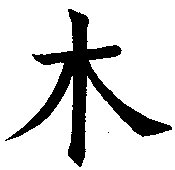|
TRANSLATIONS
Now I feel prepared to go on with henua in the glyph dictionary. First page:
|
A few preliminary
remarks and imaginations:
1. Perhaps this type of glyph
is an image of
a wooden staff (kouhau). Such were used in different circumstances:
measuring, memory aids (cutting marks in the wood), sign of power
etc.
"He [Eric Thompson]
established that one sign, very common in the [Mayan] codices where it
appears affixed to main signs, can be read as 'te' or 'che',
'tree' or 'wood', and as a numerical classifier in counts of periods
of time, such as years, months, or days.
In Yucatec, you cannot for
instance say 'ox haab' for 'three years', but must say 'ox-te
haab', 'three-te years'. In modern dictionaries 'te'
also means 'tree', and this other meaning for the sign was confirmed
when Thompson found it in compounds accompanying pictures of trees
in the Dresden Codex." (Coe)
The possible connection between a measuring staff and a numercial
classifier for time periods made me early on in these studies
conclude it was the origin of the glyph
type henua. At tagata ('a fully grown season') I have therefore suggested that henua glyphs
(here below Eb3-3 and Eb5-6) were used in the meaning 'season', 'period', etc:
|
Although in G the location of summer in the text now is definitely determined, in E we have no such security. The suggested readings (of 'winter' respectively 'summer') could be wrong, but I will let them remain until disproven.
2. My
confidence lead me to further speculations:
'Winter' has
the short ends of the staff
indented
meaning less sun. The
man in 'winter' has a 'barren' Y-shaped hand and his elbow ornament in not
complete (at spring equinox there will still remain three months
to summer solstice). The
man in 'summer' has a 'growing' arm and no incomplete elbow
ornament ...
When
the staff has
hatchmarks across it, e.g. (Ab2-38):

it probably means a time
when sun is below the horizon, and the short ends of henua are,
significantly, then never drawn indented (as in
'winter', cfr above)
...
There is a double meaning in
henua, not only a period of time but also
a connection with
light. Henua without hatchmarks means a period of light,
henua with hatchmarks a period of darkness. There are no henua in
the Mamari calendar for the
moon, because the 'land of the moon' is the night. Instead, for a
period of night the marama glyph type was used. Calendars
involving sun and light use henua (or tapa
mea.as in the 'calendar' for the daytime). In the
Japanese language yellow is 'kiiro' (ki-iro =
tree-colour) and 'tree' is written with the Chinese character
showing a tree:
 
The four examples at right are early variants (ref. Lindqvist). The
wood of a tree is yellow and the sun is yellow, therefore the stem
of a tree could be used as a symbol for the sun and - more precisely
used - as the path of
the sun.
On the other hand, the Chinese had also another character derived
from the picture of a tree, and this they used for the colour red (aka
in Japanese):

In the early examples of this character the stem of the tree is
marked with a dot (middle) or a horizontal line (right). The Chinese used the stem of certain trees to make
red colour pigment. Red or yellow - both colours are like
the sun. On Easter Island they preferred to use the hard reddish
wood from toromiro for all kinds of wood work, like houses,
canoes and sculptures. This kind of wood was in ancient times
sacred. To illustrate the path of the sun the stem of a tree
was used. That is the origin of the picture behind the henua
glyph type ...
|
Numerical classifiers may be in the background, being the reason why there are different time period endings:
|
3. Gradually doubts were accumulating. A major obstacle was
Metoro. If he saw
a piece of land
in this glyph type then surely it could not at the same time be a picture of a tree stem
(or measuring staff). My esteem of Metoro has steadily
grown and he certainly knew what he was talking about.
The Mayan te glyph - I have learnt - has no resemblance at
all with henua:

A sun symbol is at left (like an eye with a pupil in the middle), while at right - I guess - is a picture of the sky from
which what looks like 'rabbits teeth' are shining down, delivering their rays
(illustrated like the 'feathers' in rongorongo) to
earth below. This was a wooden club used for aggression, not a
peaceful agricultural tool. (The picture is from Kelley, the words
and imaginations are mine.)
Using a Mayan structure for sun
'residences' over the year the parallel to henua instead
should be the time of maximum growth before the arrival of midsummer:

Here the so-called 'Rain God' (Kelley's term for the sun) is seen walking on land - footprints are
used for describing the 'residence', his station in time, viz.
'land'.
Footprints can only be created on the surface of earth, neither sea
nor sky can do. The outline of
the rectangular form at bottom may be the origin of the henua
glyph type, I reasoned.
But I did not assume any contact between the Polynesian and the
Mayan peoples - a piece of land will be drawn as a rectangular form
irrespective of where on earth we look.
|
He has a double head-piece. Perhaps different versions of the head-piece could give information:
|






















